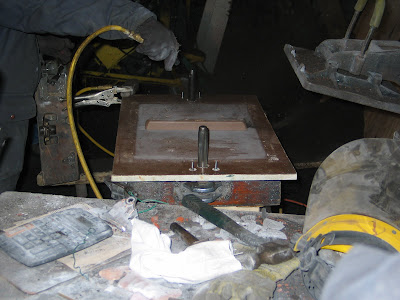




Tom-- That's true, Brian Jungen's work is particularly relevant in that the common object of the lawn chair is so abstracted that it becomes something else. Your comment is highly relevant since as an assembly, I do not want the tires to read so much as individual parts but rather as a layers breaking the visibility into the pit below-- creating a visible foreground of small framed views-- a cloud in the sense that it is not a dense object-- but an object imposed on the view nonetheless. I might come talk to you Tom later this week when I start to wrestle with how this thing can precariously balance on my two slender posts and need more Jungen inspiration or anybody else :)
I agree too that not all the tires should be in good shape. I am actually hoping to get ones that are without treads, older and starting to rust, even bent for most of it (the two Ottawa bike dump's winters hours don't include Sundays, Mondays or Tuesdays so it will be tomorrow but I counted 40 available tires to barter for already) I could stay on the bike theme-- and integrate sprockets-- but I could also investigate into other circular framing devices which is more likely my path to come. (See attached photos of stove element catchers attached with simple nuts and bolts-- which if I integrate I would dismantle and integrate into the greater whole)... This part will take some thinking and material explorations-- I will see what works in the next few days for the basis of my decision.
As for today-- I built two railing footings which sink into the concrete floor of the pit. I wanted to minimize the vertical emphasis to the floor of the sculptural railing which will instead emphasis is the cloud of tires which has left them quite slender indeed. I used 5/8" tubing over a 1/2" threaded rod which is tied down with nuts into both the footing and into the fork of the bike but was sure to make all my own washers to fit just so and weld in logical sequencing. And yet, they are not as sturdy as I would like so I will try stiffening them still. I might also slip an extra tube into the part in the ground since the prototype I have from the pit is actually also too loose-- so I could gain some lateral support if I build the difference in hole girth perhaps. This part is reminding me very much of how Rubins needed to often sink in a structural leg at least as big as sculpture height into the ground-- only that I am not allowed such a luxury in my site. I can't help but remember reading that a number of her structures collapsed...
I'm attaching today's progress in photos set into the site. I am content that the 5/8" tube that meets ground camouflages itself quite well so I imagine the sculptural elements will succeed in attaining their prominent hierarchical position in the final design.



























